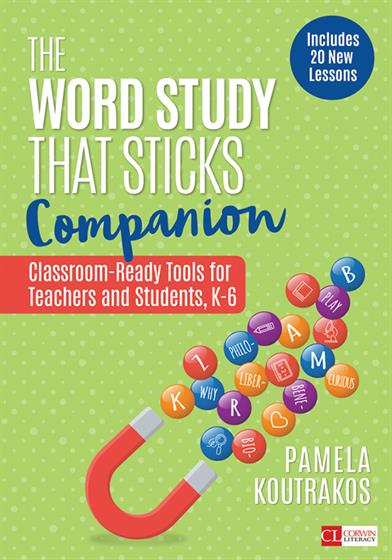Acknowledgments
Introduction
PART I: LAUNCHING CURIOUS, CREATIVE WORD STUDY
CHAPTER ONE: Building Vision for Word Learning
Teaching and Tools Make for a Purposeful Partnership
Multifaceted Word Study
Organizing Our Time: Creating a Cycle of Word Learning
Minichart Essentials
Getting Started: A Successful Launch for a Year of Word Learning
Building Repertoire: Active and Engaged Word Learning All Year
Checking In: Noticing Growth and Maintaining Progress
How to Navigate This Book
CHAPTER TWO: Visual Tour of a Word Study Notebook and Kindergarten Choice Chart
Word Study Notebooks
Balanced Use of Technology: Thinking Through the When and Why of Digital Notebooks
Kindergarten Choice Charts
CHAPTER THREE: Resources to Lighten the Load
Creating Inviting Learning Spaces
Setting Up Schedules That Encourage Independence
What Words Will We Use? Matching Students to Words
Using Assessment Information to Build Upon Class Strengths
Using Assessment Information to Build Upon Small-Group Strengths
Using Assessment Information to Build Upon Individual Strengths
Student Action Plan
Responsive Instruction and Feedback Support Success
Fostering Independence
Goal-Setting Templates (Primary)
Goal-Setting Templates (Upper-Elementary and Middle Grades)
Reflection Protocol Templates (Kindergarten)
Reflection Protocol Template (Primary)
Reflection Protocol Template (Upper-Elementary Grades)
PART II: TOOLS TO FOSTER ENGAGEMENT AND INDEPENDENCE
CHAPTER FOUR: Meaning Routines
Why Is Meaning Work Important?
How Does Meaning Work Fit a Range of Learners?
When Do Learners Engage in Meaning Work?
Primary-Grade Minicharts for Meaning Routines
Upper-Elementary Grade Minicharts for Meaning Routines
CHAPTER FIVE: Phonemic Awareness and Phonics Routines
Why Is This Phonemic Awareness and Phonics Work Important?
How Does Phonemic Awareness and Phonics Work Fit a Range of Learners?
When Do Learners Engage in Phonemic Awareness and Phonics Work?
Primary-Grade Minicharts for Phonemic Awareness and Phonics Routines
Upper-Elementary Grade Minicharts for Phonemic Awareness and Phonics Routines
CHAPTER SIX: Spelling Pattern Routines
Why Is Spelling Pattern Work Important?
How Does Spelling Pattern Work Fit a Range of Learners?
When Do Learners Engage in Spelling Pattern Work?
Primary-Grade Minicharts for Spelling Pattern Routines
Upper-Elementary Grade Minicharts for Spelling Pattern Routines
CHAPTER SEVEN: Habit and Hybrid Routines
Why Are Habit and Hybrid Word Work Routines Important?
How Do Habit and Hybrid Word Work Fit a Range of Learners?
When Do Learners Engage in Habit and Hybrid Word Work?
Primary-Grade Minicharts for Habit and Hybrid Routines
Upper-Elementary Grade Minicharts for Habit and Hybrid Routines
CHAPTER EIGHT: Check-In and Assessment Routines
Why Are Check-In and Assessment Routines Important?
How Do Check-In and Assessment Routines Fit a Range of Learners?
When Do Learners Engage in Check-In and Assessment Routines?
Primary-Grade Minicharts for Check-In and Transfer Routines
Upper-Elementary Grade Minicharts for Check-In and Transfer Routines
PART III: EXTENDING WORD LEARNING
CHAPTER NINE: Connecting With Caregivers
We’re Better Together: Tools to Reinforce Home-School Partnership
A Brief Word on Homework
After-Hours Activities Letters
Student-Caregiver-Teacher Communication Tools
CHAPTER TEN: Bonus Lessons to Bolster Word Study Engagement and Success
Bonus Meaning Lessons
Bonus Phonemic Awareness and Phonics Lessons
Bonus Spelling Pattern Lessons
Bonus Hybrid Lessons
Conclusion: Teacher Talk: Tales From the Classroom
Appendix
Appendix A: Frequently Asked Questions—and Answer
Appendix B: If/Then Chart for Matching Students to Patterns and Words
Appendix C: Word Study Routines at a Glance
Appendix D: Word Study Routines and Resources
References
Index



